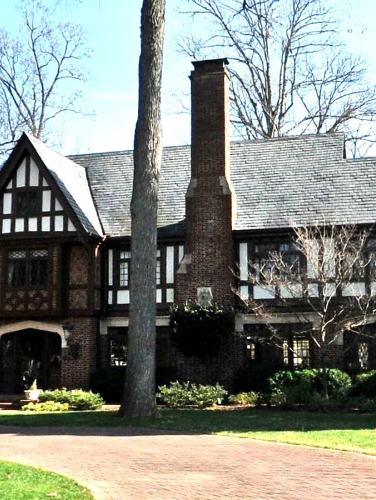
Earle Sumner Draper House
(ca. 1923)
One of the South’s most prolific professionally trained landscape architects of the early 20th century once called the Earle Sumner Draper House home.
1621 Queens Rd, Charlotte, NC 28207
In contrast to the square pattern of Charlotte’s uptown, the curved patterns of the city’s earliest suburbs Dilworth and Myers Park were the work of the planning firms of the Olmsted Brothers and John Nolen (1869-1937), hired by Edward Dilworth Latta (1851-1925) and George Stephens (1873-1946) respectively to lay out some of their respective developments. Both firms later became nationally prominent planning trendsetters.
Property Quick Links
In 1905, Nolen – a graduate of the Wharton School and Harvard who maintained an office in Cambridge, Massachusetts – designed Charlotte’s Independence Park. For two years, he planned the landscape for many of the city’s private residences. He was called back by Stephens in 1911 to lay out Myers Park. Four years later, Nolen hired Earle Sumner Draper (1893-1994), a graduate of Massachusetts Agricultural College (now the University of Massachusetts), to supervise the field work. One of the perks offered to those who purchased Myers Park lots was a landscape design by Draper. As a one-day-per-month sideline, Draper also supervised construction of the town of Kingsport, Tennessee. In 1917, just two years after coming to Charlotte, Draper went into business for himself, with his mentor's approval.
For the next sixteen years – from branch offices in Atlanta, Washington, D.C. and New York – Draper’s firm (possibly the Southeast’s first resident firm of a professionally trained landscape architect) enjoyed the boom times of the late 1910s and 1920s throughout the South. The firm was one of the five largest such firms in the U.S. and designed over a hundred suburbs, including areas within Charlotte’s Myers Park and Eastover neighborhoods and parts of the Davidson and Winthrop College campuses. He also executed designs for some 150 mill villages or village extensions.
Draper purchased the Queens Road lot in 1918, but did not start construction until five years later. He chose Franklin Gordon (1870-1930), then one of Charlotte’s senior architects, to design his home. A Maine native, Gordon came to Charlotte in 1905 as supervising architect for the Selwyn Hotel. Once that project was complete, he remained in Charlotte, partnering with Leonard Legrand Hunter (1881-1925) and becoming a founding member of the North Carolina Architects Association. Their firm earned such notable commissions as Charlotte’s Mercy Hospital, the Chalmers A.R.P. Church on South Boulevard, and the Carnegie Library at Johnson C. Smith University. Known for his Tudor Revival and Colonial Revival residences, the Draper House is one of finest local examples of Gordon’s skillful use of the Tudor Revival style. The landscape design, naturally enough, was executed by Draper himself.
Numerous career opportunities outside of Charlotte – including positions as the Director of Town Planning and Housing for the Tennessee Valley Authority and in the upper echelons of the Federal Housing Authority – prompted the Draper family to leave Charlotte in 1932. Originally intending to return, the Drapers rented out their Queens Road home, ultimately selling the house to local businessman Thomas F. Kerr (1885-1962) in 1944.

